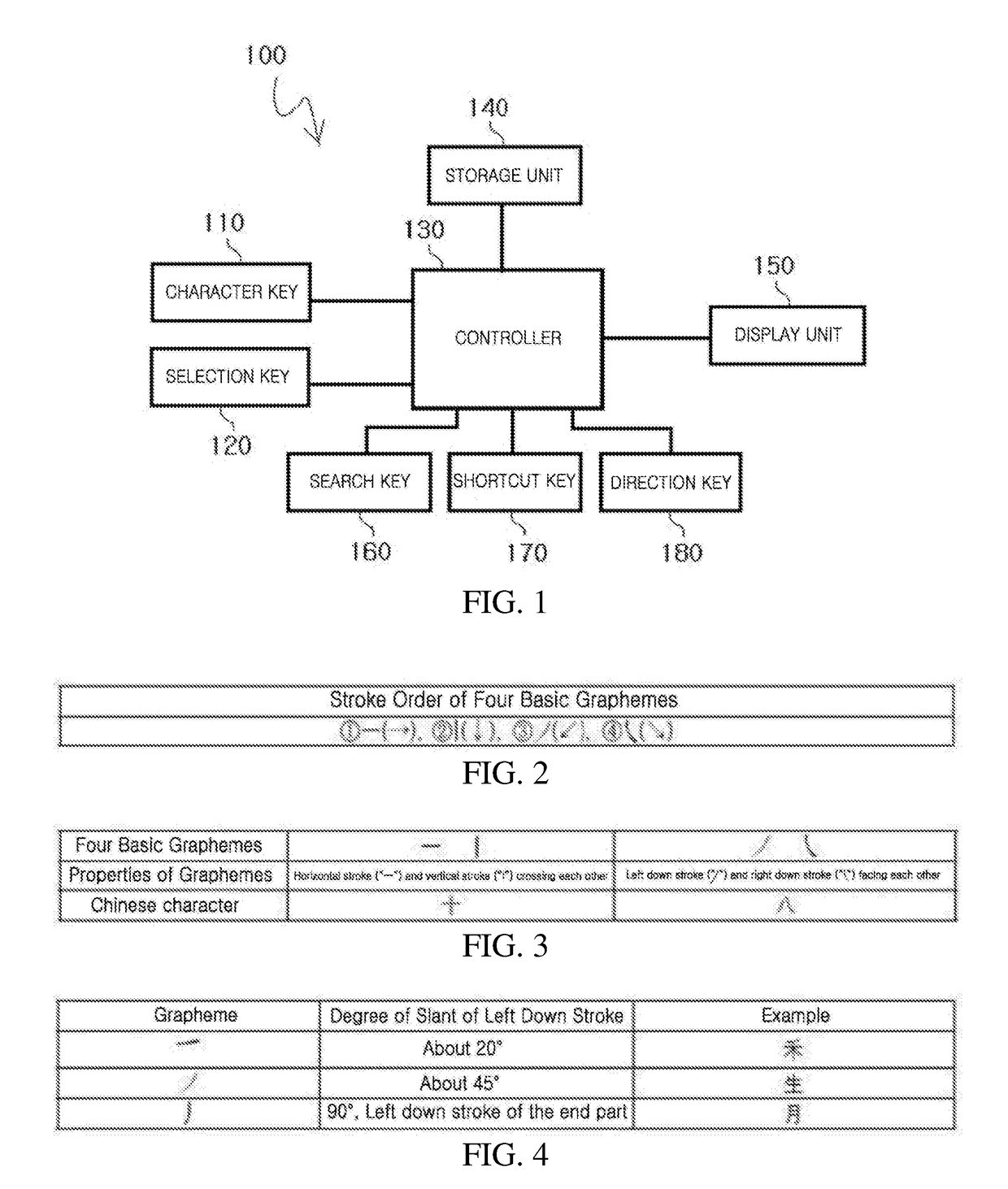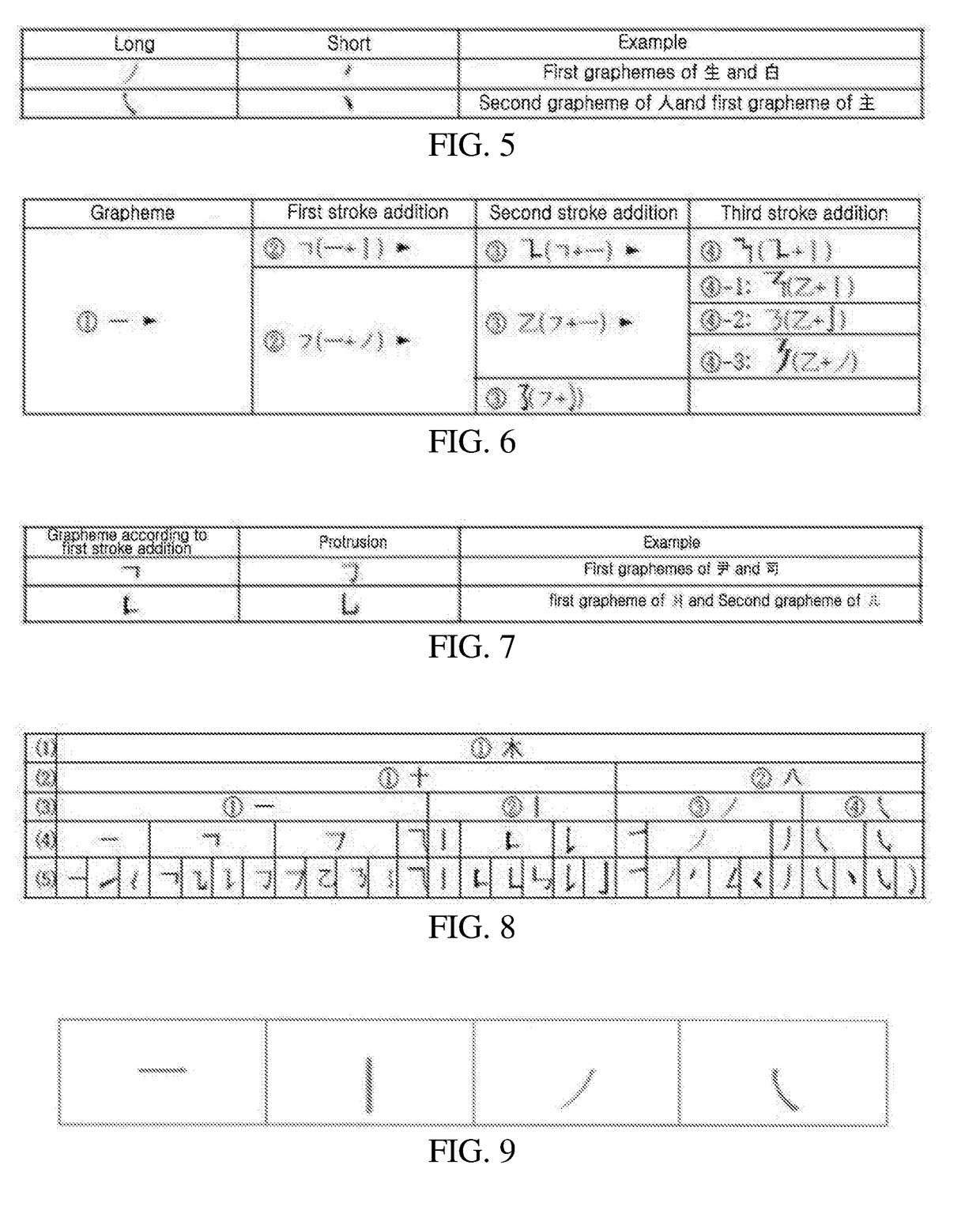Device and method for inputting chinese characters, and chinese character search method using same
- Summary
- Abstract
- Description
- Claims
- Application Information
AI Technical Summary
Benefits of technology
Problems solved by technology
Method used
Image
Examples
embodiment 1
[0142]Hereinafter, a description will be given of application of the “” character system to the method of search by radicals. If Chinese characters are matched with a list of all radicals including variants produced over time, the search operation may be performed without inconvenience even if the radical of a character changes. For example, a user who is aware of the traditional Chinese character “ ([si], to see)” only needs to use the radical “ ([gjn], to see)” to search for the character, and a user who is aware of the simplified Chinese character “ ([si], to see)” only needs to use the radical “ ([si], to show)” to search for the character. As another example, a user who is aware of the traditional Chinese character “ ([gun], military)” only needs to use the radical “ ([g], a rickshaw) to search for the character, and a user who is aware of the simplified Chinese character “ ([gun], military)” only needs to use the radical ([mjk], to cover)” to search for the character. Accordi...
embodiment 2
[0152]Hereinafter, comparison between a pinyin input method for a conventional cellular phone (e.g., iPhone 5) and the “” pinyin input method of the present invention will be discussed to describe application of the “” character system to a method of inputting pronunciation. The pinyin list of the simplified Chinese characters appearing on the conventional cellular phone has the following 103 characters:
[0153]rn: , r{hacek over (a)}n:
[0154]rāng: , ráng: , r{hacek over (a)}ng: , rng:
[0155]ráo: , r{hacek over (a)}o: , r:
[0156]r{hacek over (e)}: , r:
[0157]rn: , r{hacek over (e)}n: , rèn:
[0158]rēng: , réng:
[0159]r:
[0160]rng: , r{hacek over (o)}ng:
[0161]ru: , ru:
[0162]r: , r{hacek over (u)}: , r:
[0163]ru{hacek over (a)}n:
[0164]ru: , ru{hacek over (i)}: , ruì:
[0165]rn:
[0166]ru:
[0167]According to the “” character system, the 103 characters are arranged as: “,”“,”“,”“,”“”“,”“,”“,”“,”“,”“,”“,”“,”“,”“, ”“,”“,”“,”“,”“,”“,”“,”“,”“,”“,”“,”“,”“,”“,”“,”“,”“,”“,”“,”“,”“,”“,”“,”“,”“,”“,...
embodiment 3
[0174]For the conventional cellular phone as shown in FIG. 43, when the user selects and inputs “r” pronunciation according to the pinyin method for simplified Chinese characters, the next 12 characters appear. To input and implement the 12 characters, 2 inputs or 3 inputs are needed.
[0175]According to the “” pinyin input method, when “r” is input, 28 characters are displayed. Then, a Chinese character is input by touching the Chinese character. Accordingly, two inputs are taken to input the Chinese character. To search for a Chinese character from among the 29th Chinese character and following Chinese characters, the direction keys are used, thus thee inputs are needed to input the intended Chinese character. With the “” pinyin input method, 252 or fewer characters can be input through 3 or fewer inputs. With the conventional cellular phone, on the other hand, it is not possible to process 103 characters through 3 or fewer inputs.
PUM
 Login to View More
Login to View More Abstract
Description
Claims
Application Information
 Login to View More
Login to View More - R&D
- Intellectual Property
- Life Sciences
- Materials
- Tech Scout
- Unparalleled Data Quality
- Higher Quality Content
- 60% Fewer Hallucinations
Browse by: Latest US Patents, China's latest patents, Technical Efficacy Thesaurus, Application Domain, Technology Topic, Popular Technical Reports.
© 2025 PatSnap. All rights reserved.Legal|Privacy policy|Modern Slavery Act Transparency Statement|Sitemap|About US| Contact US: help@patsnap.com



